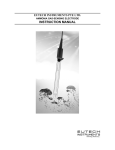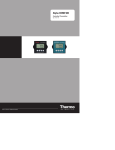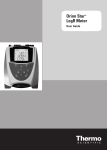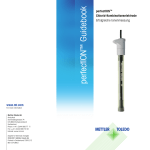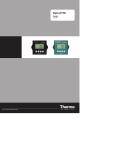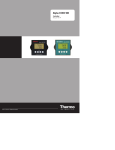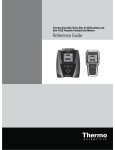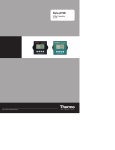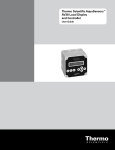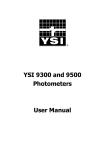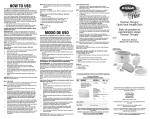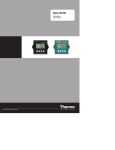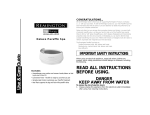Download User Guide - Instrumart
Transcript
User Guide Chloride Ion Selective Electrode ROSS and the COIL trade dress are trademarks of Thermo Fisher Scientific Inc. AQUAfast, Cahn, ionplus, KNIpHE, No Cal, ORION, perpHect, PerpHecT, PerpHecTion, pHISA, pHuture, Pure Water, Sage, Sensing the Future, SensorLink, ROSS, ROSS Ultra, Sure-Flow, Titrator PLUS and TURBO2 are registered trademarks of Thermo Fisher. 1-888-pHAX-ION, A+, All in One, Aplus, AQUAsnap, AssuredAccuracy, AUTO-BAR, AUTO-CAL, AUTO DISPENSER, Auto-ID, AUTO-LOG, AUTO-READ, AUTO-STIR, Auto-Test, BOD AutoEZ, Cable-Free, CERTI-CAL, CISA, DataCOLLECT, DataPLUS, digital LogR, DirectCal, DuraProbe, Environmental Product Authority, Extra Easy/Extra Value, FAST QC, GAP, GLPcal, GLPcheck, GLPdoc, ISEasy, KAP, LabConnect, LogR, Low Maintenance Triode, Minimum Stir Requirement, MSR, NISS, One-Touch, One-Touch Calibration, One-Touch Measurement, Optimum Results, Orion Star, Pentrode, pHuture MMS, pHuture Pentrode, pHuture Quatrode, pHuture Triode, Quatrode, QuiKcheK, rf link, ROSS Resolution, SAOB, SMART AVERAGING, Smart CheK, SMART STABILITY, Stacked, Star Navigator 21, Stat Face, The Enhanced Lab, ThermaSense, Triode, TRIUMpH, Unbreakable pH, Universal Access are trademarks of Thermo Fisher. Guaranteed Success and The Technical Edge are service marks of Thermo Fisher. PerpHecT meters are protected by U.S. patent 6,168,707. PerpHecT ROSS are protected by U.S. patent 6,168,707. ORION Series A meters and 900A printer are protected by U.S. patents 5,198,093, D334,208 and D346,753. ionplus electrodes and Optimum Results solutions are protected by US Patent 5,830,338. ROSS Ultra electrodes are protected by US patents 6,793,787. Orion ORP Standard is protected by US Patent 6,350,367. Orion NoCal electrodes are protected by US Patent 7,276,142. © 2008 Thermo Fisher Scientific Inc. All rights reserved. All trademarks are the property of Thermo Fisher Scientific Inc. and its subsidiaries. The specifications, descriptions, drawings, ordering information and part numbers within this document are subject to change without notice. This publication supersedes all previous publications on this subject. Table of Contents General Information . . . . . . . . . . . . . . . . . . . . . . . . . . 1 Introduction . . . . . . . . . . . . . . . . . . . . . . . . . . . . . . . . . . . . . . . 1 Required Equipment . . . . . . . . . . . . . . . . . . . . . . . . . . . . . . . . 2 Using the Electrode . . . . . . . . . . . . . . . . . . . . . . . . . . 3 Electrode Preparation . . . . . . . . . . . . . . . . . . . . . . . . . . . . . . . . Checking Electrode Operation (Slope) . . . . . . . . . . . . . . . . . . . Before Analysis . . . . . . . . . . . . . . . . . . . . . . . . . . . . . . . . . . . . Units of Measurement . . . . . . . . . . . . . . . . . . . . . . . . . . . . . Sample Requirements . . . . . . . . . . . . . . . . . . . . . . . . . . . . . Measuring Hints . . . . . . . . . . . . . . . . . . . . . . . . . . . . . . . . . . . . 3 4 5 5 5 6 Analytical Procedures . . . . . . . . . . . . . . . . . . . . . . . . 7 Analytical Techniques . . . . . . . . . . . . . . . . . . . . . . . . . . . . . . . . 7 Direct Calibration . . . . . . . . . . . . . . . . . . . . . . . . . . . . . . . . . . . 9 Low-Level Measurement . . . . . . . . . . . . . . . . . . . . . . . . . . . . 12 Known Addition . . . . . . . . . . . . . . . . . . . . . . . . . . . . . . . . . . . 14 Electrode Storage . . . . . . . . . . . . . . . . . . . . . . . . . . . . . . . . . 20 Troubleshooting . . . . . . . . . . . . . . . . . . . . . . . . . . . . 22 Troubleshooting Checklist . . . . . . . . . . . . . . . . . . . . . . . . . . . 22 Troubleshooting Guide . . . . . . . . . . . . . . . . . . . . . . . . . . . . . . 24 Electrode Characteristics . . . . . . . . . . . . . . . . . . . . . 26 Electrode Response . . . . . . . . . . . . . . . . . . . . . . . . . . . . . . . . Reproducibility . . . . . . . . . . . . . . . . . . . . . . . . . . . . . . . . . . . . Temperature Effects . . . . . . . . . . . . . . . . . . . . . . . . . . . . . . . . Interferences . . . . . . . . . . . . . . . . . . . . . . . . . . . . . . . . . . . . . Use of CISA . . . . . . . . . . . . . . . . . . . . . . . . . . . . . . . . . . . . . . Complexation and Precipitation . . . . . . . . . . . . . . . . . . . . . . . Electrode Life . . . . . . . . . . . . . . . . . . . . . . . . . . . . . . . . . . . . . Theory of Operation . . . . . . . . . . . . . . . . . . . . . . . . . . . . . . . 26 27 27 28 29 29 30 30 Assistance . . . . . . . . . . . . . . . . . . . . . . . . . . . . . . . . 32 Warranty . . . . . . . . . . . . . . . . . . . . . . . . . . . . . . . . . . 32 Ordering Information . . . . . . . . . . . . . . . . . . . . . . . . 33 Specifications . . . . . . . . . . . . . . . . . . . . . . . . . . . . . . 34 General Information Introduction This user guide contains information on the preparation, operation and maintenance for the chloride ion selective electrode (ISE). General analytical procedures, electrode characteristics and electrode theory are also included in this user guide. Chloride electrodes measure free chloride ions in aqueous solutions quickly, simply, accurately and economically. Technical Support Chemists can be consulted for assistance and troubleshooting advice. Within the United States call 1.800.225.1480 and outside the United States call 978.232.6000 or fax 978.232.6031. In Europe, the Middle East and Africa, contact your local authorized dealer. For the most current contact information, visit www.thermo.com/contactwater. For more information on our full product offering, visit www.thermo.com/water. Chloride ionplus® Sure-Flow® Solid State Combination ISE The reference and sensing electrodes are built into one electrode, which decreases the amount of required solution and reduces waste. The built-in Sure-Flow reference junction prevents electrode clogging and provides fast and stabile readings. The chloride ionplus combination ISE is available with a waterproof BNC connector, Cat. No. 9617BNWP. Electrodes with a waterproof BNC connector can be used on any ISE meter with a BNC connection. Chloride Solid State Half-Cell ISE The chloride half-cell electrode must be used with the double junction reference electrode, Cat. No. 900200. The chloride halfcell is available with a BNC connector, Cat. No. 9417BN and a screw cap connector, Cat. No. 9417SC. Electrodes with a screw cap connector require a separate cable. Chloride Ion Selective Electrode User Guide Required Equipment 1. Thermo Scientific Orion ISE meter, such as the 4-Star pH/ ISE meter or 5-Star pH/ISE/DO/conductivity meter. Chloride electrodes can be used on any ISE meter with a BNC connection. The electrodes can also be used on meters with a variety of inputs when an adapter cable is used. Visit www.thermo.com/water for details. 2. Thermo Scientific Orion chloride ion selective electrode. The 9417BN and 9417SC chloride half-cell electrodes require a separate reference electrode, Cat. No. 900200. 3. Magnetic stirrer or stirrer probe, Cat. No. 096019. The stirrer probe can be used with 3-Star, 4-Star and 5-Star benchtop meters. 4. Volumetric flasks, graduated cylinders and beakers. 5. Polishing strips, Cat. No. 948201, to polish a dirty or etched sensing element. 6. Distilled or deionized water. 7. Chloride electrode filling solution. Use Optimum Results B filling solution, Cat. No. 900062, for the 9617BNWP chloride combination electrode. For samples that have a chloride concentration greater than 10-2 M (355 ppm), use Cat. No. 900001 filling solution. Use the inner chamber filling solution, Cat. No. 900002, and outer chamber filling solution, Cat. No. 900003, that are shipped with the double junction that is used with the 9417BN and 9417SC chloride half-cell electrodes. 8. Chloride calibration standards. 0.1 M sodium chloride standard, Cat. No. 941706 1000 ppm chloride standard, Cat. No. 941708 100 ppm chloride standard, Cat. No. 941707 9. Ionic strength adjuster (ISA), Cat. No. 940011. To adjust ionic strength of samples and standards. 10. CISA, Cat. No. 941709. To remove interferences, see the Use of CISA section. Chloride Ion Selective Electrode User Guide Using the Electrode Electrode Preparation 9417BN and 9417SC Chloride Half-Cell Electrodes 1. Remove the rubber cap covering the electrode tip. 2. Fill the 900200 double junction reference electrode according to instructions in the reference electrode user guide. Fill the inner chamber with Cat. No. 900002 and the outer chamber with Cat. No. 900003. 9617BNWP Chloride Combination Electrode The filling solution, Cat. No. 900062, supplied with this electrode is designed to minimize junction potentials and chloride ion contamination of the sample, and can be used for all chloride measurements. An additional filling solution, Cat. No. 900001, is available that is designed for use in samples more concentrated than 10-2 M chloride. The electrode potential characteristics of the reference electrode portion, when using the Cat. No. 900001 solution, match those of a conventional saturated KCl calomel reference electrode. NOTE: Use of other filling solutions will void the warranty on the electrode. Use of Cat. No. 900017 chloride electrode filling solution is acceptable for these electrodes. Filling Instructions The electrode is shipped without filling solution in the reference chamber. To fill from the flip-spout bottle: 1. Lift the spout to a vertical position and insert the spout into the fill hole in the outer sleeve. Add a small amount of filling solution to the chamber. Tip the electrode to moisten the O-ring and turn electrode to a vertical position. 2. Holding the electrode by the barrel with one hand, use the thumb to push down on the electrode cap, allowing a few drops of filling solution to drain to wet the inner cone. 3. Release electrode cap and allow sleeve to return to original position. Add filling solution just below the fill hole. 4. If sleeve does not return to its original position immediately, check to see if the O-ring is moist enough and repeat steps 1-3 until the sleeve has returned to original position. NOTE: Add filling solution each day before using electrode. The filling solution level should be at least one inch above the level of sample to ensure a proper flow rate. Chloride Ion Selective Electrode User Guide Checking Electrode Operation (Slope) These are general instructions which can be used with most meters to check electrode operation. See the meter user guide for more specific information. This procedure measures electrode slope. Slope is defined as the change in millivolts observed with every tenfold change in concentration. Obtaining the slope value provides the best means for checking electrode operation. 1. If electrode(s) have been stored dry, prepare the electrode(s) as described under the section entitled Electrode Preparation. 2. Connect electrode(s) to the meter. Non-Thermo Scientific Orion meters may require special adapters. Consult your meter user guide. 3. Place 100 mL distilled water in a 150 mL beaker. Add 2 mL ISA, Cat. No. 940011. Stir thoroughly. Set the meter to the mV mode. 4. Rinse electrode(s) with distilled water and place in the solution prepared in step 3 above. 5. Select either 0.1 M chloride standard, Cat. No. 941706, or 1000 ppm chloride standard, Cat. No. 941708. Pipette 1 mL of the selected standard into the beaker. Stir thoroughly. When a stable reading is displayed, record the electrode potential in millivolts. 6. Pipette 10 mL of the same standard into the same beaker. Stir thoroughly. When a stable reading is displayed, record the electrode potential in millivolts. 7. The difference between the first and second potential reading is defined as the slope of the electrode. The difference should be in the range of 54-60 mV/decade when the solution temperature is 25 ˚C. If the difference in potential is not within this range, refer to the Troubleshooting section. Chloride Ion Selective Electrode User Guide Before Analysis Units of Measurement Chloride concentration can be measured in units of moles per liter, equivalents per liter, parts per million, or any convenient concentration unit (see Table 1). Table 1 Concentration Unit Conversion Factors Moles/Liter ppm Cl- % NaCl 10 -1 3550 0.58% 10 -2 355 0.058% 10 -3 10 -4 35.5 3.55 0.0058% 0.00058% Sample Requirements The epoxy electrode body is resistant to attack by inorganic solutions. The electrode may be used intermittently in solutions containing methanol, benzene, or acetone. Consult our Technical Support Chemists for use of electrode in specific applications. Samples and standards should be at the same temperature. Temperature must be less than 100 ˚C. Chloride Ion Selective Electrode User Guide Measuring Hints • Pipette 2 mL ISA per 100 mL of standard or sample. • Stir all standards and samples at a uniform rate during measurement. Magnetic stirrers may generate sufficient heat to change solution temperature. Place a piece of insulating material such as cork, cardboard, or styrofoam between the stirrer and beaker. • Verify calibration every two hours by placing electrodes in the first standard solution used for calibration. If the value has changed, recalibrate. • Always use fresh standards for calibration. • Always rinse electrodes with deionized water between measurements (see Electrode Preparation). Shake after rinsing to prevent solution carryover. Do not wipe or rub the sensing element. • Allow all standards and samples to come to room temperature for precise measurement. • After immersion in solution, check electrode for any air bubbles on element surface and remove by redipping electrode into solution. • For the 9417BN and 9417SC half-cell and 9617BNWP combination electrodes: If electrode response is slow, the sensing element may be coated with deposits. Restore performance by polishing the electrode with a polishing strip, Cat. No. 948201. Cut off 1 inch of the polishing strip and polish the electrode sensing element with a circular motion for about 30 seconds. Rinse and soak in a standard solution for about 5 minutes before use. • For high ionic strength samples, prepare standards with composition similar to that of the sample. Chloride Ion Selective Electrode User Guide Analytical Procedures Analytical Techniques A variety of analytical techniques is available to the analyst. The following is a description of these techniques. Direct Calibration A simple procedure for measuring a large number of samples. Only one meter reading is required for each sample. Calibration is performed in a series of standards. The concentration of the samples is determined by comparison to the standards. ISA is added to all solutions to ensure that samples and standard have similar ionic strength. Incremental Techniques A useful method for measuring samples, since calibration is not required. As in direct calibration, any convenient concentration unit can be used. The different incremental techniques are described below. They can be used to measure the total concentration of a specific ion in the presence of a large (50-100 times) excess of complexing agents. Known Addition is an alternate method useful for measuring dilute samples, checking the results of direct calibration (when no complexing agents are present), or measuring the total concentration of an ion in the presence of an excess complexing agent. The electrode(s) are immersed in the sample solution and an aliquot of a standard solution containing the measured species is added to the sample. From the change in potential before and after the addition, the original sample concentration is determined. Known Subtraction is useful as a quick version of a titration, or for measuring species for which stable standards do not exist. It is necessary to know the stoichiometric ratio between standard and sample. For known subtraction, an electrode sensing the sample species is used. Stable standards of a species reacting completely with the sample in a reaction of known stoichiometry are necessary. Chloride Ion Selective Electrode User Guide Analate Addition is often used to measure soluble solid samples, viscous samples, small or very concentrated samples, or to diminish the effects of varying sample temperatures. This method is not suitable for dilute or low concentration samples. Total concentration is measured even in the presence of complexing agents. The electrode(s) are immersed in a standard solution containing the ion to be measured and an aliquot of the sample is added to the standard. The original sample concentration is determined from the change in potential before and after the addition. Analate Subtraction is used in the measurement of ions for which no ion-selective electrode exists. The electrode(s) are immersed in a reagent solution that contains a species that the electrode senses, and that reacts with the sample. It is useful when sample size is small, or samples for which a stable standard is difficult to prepare, and for viscous or very concentrated samples. The method is not suited for very dilute samples. It is also necessary to know the stoichiometric ratio between standard and sample. Titrations Titrations are quantitative analytical techniques for measuring the concentration of a species by incremental additions of a reagent (titrant) that reacts with the sample species. Sensing electrodes can be used for determination of the titration end point. Ion selective electrodes are useful as end point detectors, because they are unaffected by sample color or turbidity. Titrations are approximately 10 times more precise than direct calibration, but are more time-consuming. Chloride Ion Selective Electrode User Guide Direct Calibration 9417BN and 9417SC Chloride Half-Cell Electrodes Setup 1. Remove the rubber cap covering the electrode tip. 2. Fill the 900200 double junction reference electrode according to instructions in the reference electrode user guide. Fill the inner chamber with Cat. No. 900002 and the outer chamber with Cat. No. 900003. 3. Connect electrodes to the meter. 4. Prepare two standards that bracket the expected sample range and differ in concentration by a factor of ten. Standards can be prepared in any concentration unit to suit the particular analysis requirement. All standards should be at the same temperature as the samples (for details on temperature effects on electrode performance, refer to Temperature Effects). 9617BNWP Chloride Combination Electrode Setup 1. Remove the rubber cap covering the electrode tip. 2. Fill the electrode according to instructions in the Electrode Preparation section. 3. Connect electrode to the meter. 4. Prepare two standards that bracket the expected sample range and differ in concentration by a factor of ten. Standards can be prepared in any concentration unit to suit the particular analysis requirement. All standards should be at the same temperature as the samples (for details on temperature effects on electrode performance, refer to Temperature Effects). If using a meter with direct concentration readout capability See the meter user guide for more specific information. 1. Measure 100 mL of the more dilute standard into a 150 mL beaker. Add 2 mL ISA. Stir thoroughly. 2. Rinse electrode(s) with deionized water, blot dry and place into the beaker. Wait for a stable reading, then calibrate the meter to display the value of the standard as described in the meter user guide. Chloride Ion Selective Electrode User Guide 3. Measure 100 mL of the more concentrated standard into a second 159 mL beaker. Add 2 mL ISA. Stir thoroughly. 4. Rinse electrode(s) with deionized water, blot dry, and place into the beaker with the more concentrated standard. Wait for a stable reading, then adjust the meter to display the value of the second standard, as described in the meter user guide. 5. Measure 100 mL of the sample into a 150 mL beaker. Add 2 mL ISA. Stir thoroughly. Rinse electrode(s) with distilled water, blot dry and place into sample. The concentration will be displayed on the meter. Figure 1 — Typical Chloride Electrode Calibration Curve In the direct calibration procedure, a calibration curve is constructed on semi-logarithmic paper. Electrode potentials of standard solutions are measured and plotted on the linear axis against their concentrations on the log axis. In the linear regions of the curves, only three standards are needed to determine a calibration curve. In non-linear regions, more points must be taken. The direct measurement procedures in the user guide are given for concentrations in the region of linear electrode response. Low-level measurement procedures are given for measurements in the non-linear region. 10 Chloride Ion Selective Electrode User Guide If using a meter with millivolt readout only 1. Adjust the meter to measure mV. 2. Measure 100 mL of the more dilute standard into a 150 mL beaker. Add 2 mL ISA. Stir thoroughly. 3. Rinse electrode(s) with distilled water, blot dry and place into the beaker. When a stable reading is displayed, record the mV value and corresponding standard concentration. 4. Measure 100 mL of the more concentrated standard into a second 150 mL beaker. Add 2 mL ISA. Stir thoroughly. 5. Rinse electrode(s) with deionized water, blot dry and place into the second beaker. When a stable reading is displayed, record the mV value and corresponding standard concentration. 6. Using a semi-logarithmic graph paper, prepare a calibration curve by plotting the millivolt values on the linear axis, and the standard concentration values on the logarithmic axis. 7. Measure 100 mL of sample into a 150 mL beaker. Add 2 mL ISA. Stir thoroughly. 8. Rinse electrode(s) with deionized water, blot dry, and place into the beaker. When a stable reading is displayed, record the mV value. 9. Using the calibration curve prepared in step 6, determine the unknown concentration. Chloride Ion Selective Electrode User Guide 11 Low-Level Measurement These procedures are for low ionic strength solutions with a chloride concentration of less than 10-4 M. For solutions low in chloride but high in total ionic strength, perform the same procedure with one change, prepare a calibration solution with a composition similar to the sample. Accurate measurement requires that the following conditions be met. • Adequate time must be allowed for electrode stabilization. Longer response time will be needed at low levels. • Stir all standards and samples at a uniform rate. For meters with only a millivolt scale, without special low-level procedures, or without blank correction, prepare a calibration curve as outlined below. Setup 1. Remove the plastic cap covering the electrode tip. 2a. 9417BN and 9417SC: Fill the 900200 double junction reference electrode according to instructions in the reference electrode user guide. Fill the inner chamber with Cat. No. 900002 and the outer chamber with Cat. No. 900003. 2b. 9617BNWP: Fill electrode with selected filling solution. See instructions in the Electrode Preparation section. 3. Connect the electrodes to the meter. Set the meter to read mV. 4. Select a standard solution. Use either 1000 ppm NaCl standard, Cat. No. 941708, or dilute the 0.1 M chloride standard, Cat. No. 941706, to 10-2 M. 5. Prepare a low-level ISA solution (1.0 M NaNO3) by diluting 20 mL of ISA, Cat. No. 940011, to 100 mL with distilled water. Use this low-level ISA solution for low-level measurements only. 12 Chloride Ion Selective Electrode User Guide Measurement 1. Measure 100 mL distilled water into a 150 mL beaker. Add 1 mL low-level ISA. 2. Rinse the electrode(s) with deionized water and place into beaker. Stir thoroughly. 3. Add increments of the 1000 ppm or 10-2 M chloride standard to the beaker using steps outlined in Table 2. Record stable millivolt reading after each increment. On semi-logarithmic paper, plot the concentration (log axis) against the millivolt potential (linear axis). See Figure 2. Prepare a new calibration curve with fresh standards each day. 4. Measure 100 mL of sample into a beaker. Rinse the electrode(s) with distilled water, blot dry, and place into sample. Add 1 mL low-level ISA to 100 mL sample. 5. Stir thoroughly. When a stable reading is displayed, record the mV value. 6. Determine the sample concentration corresponding to the measured potential from the low-level calibration curve. Table 2 Serial Calibration For Low-Level Measurements Additions of 1000 ppm or 10 -2 M standards to 100 mL distilled water, plus 1 mL low-level ISA. Step Graduated Pipette Size Added Volume Concentration ppm Molarity 1 1 mL 0.1 mL 1.0 1.0 x 10 -5 2 1 mL 0.1 mL 2.0 2.0 x 10 -5 3 1 mL 0.2 mL 4.0 4.0 x 10 -5 4 1 mL 0.2 mL 6.0 6.0 x 10 -5 5 1 mL 0.4 mL 9.9 9.9 x 10 -5 6 2 mL 2.0 mL 29 2.9 x 10 -4 7 2 mL 2.0 mL 48 4.8 x 10 -4 Chloride Ion Selective Electrode User Guide 13 Known Addition Known addition is a convenient technique for measuring samples because no calibration curve is needed. It can be used to verify the results of a direct calibration or to measure the total concentration of an ion in the presence of a large excess of a complexing agent. The sample potential is measured before and after addition of a standard solution. Accurate measurement requires that the following conditions be met: • Concentration should approximately double as a result of the addition. • Sample concentration should be known to within a factor of three. • In general, either no complexing agent or a large excess of the complexing agent may be present. • The ratio of the uncomplexed ion to complexed ion must not be changed by addition of the standard. • All samples and standards should be at the same temperature. Setup 1. Remove the plastic cap covering the electrode tip. 2a. 9417BN and 9417SC: Fill the 900200 double junction reference electrode according to the instructions in the reference electrode user guide. Fill the inner chamber with Cat. No. 900002 and the outer chamber with Cat. No. 900003. 2b. 9617BNWP: Fill electrode with selected filling solution. See instructions in the Electrode Preparation section. 3. Connect the electrode(s) to the meter. 4. Prepare a standard solution which, upon addition to the sample, will cause the concentration of the chloride ion to double. Refer to Table 3 as a guideline (Sample volume 100 mL). 5. Determine the slope of the electrode by performing the procedure in Checking Electrode Operation (Slope). 6. Rinse electrode(s) between solutions with deionized water. Table 3 Volume of addition Concentration of Standard 1 mL 100 x sample concentration 5 mL 20 x sample concentration 10 mL* 10 x sample concentration * Most convenient volume to use. 14 Chloride Ion Selective Electrode User Guide If using an instrument with direct known addition readout capability See the meter user guide for more specific information. 1. Set up the meter to measure in the Known Addition mode. 2. Measure 100 mL of the sample into a beaker. Rinse electrodes with distilled water and place in sample solution. Add 2 mL ISA. Stir thoroughly. 3. When a stable reading is displayed, set the meter as described in the meter user guide. 4. Pipette the appropriate amount of the standard solution into the beaker. Stir thoroughly. 5. When a stable reading is displayed, record the sample concentration. Analysis using a meter with millivolt readout only Use this procedure when no instructions for Known Addition are available in the meter user guide. 1. Set the meter to relative millivolt mode. 2. Measure 100 mL of sample into a 150 mL beaker. Add 2 mL ISA. Stir thoroughly. 3. Rinse electrode(s) with distilled water, blot dry, and place into beaker. When a stable reading is displayed, set the reading to 000.0 by turning the calibration control. If the reading cannot be set to 000.0, record the mV value. 4. Pipette the appropriate amount of standard solution into the beaker. Stir thoroughly. 5. When a stable reading is displayed, record the mV value. If the meter could not be zeroed in step 3, subtract the first reading from the second to find ∆E. Chloride Ion Selective Electrode User Guide 15 6. From Table 4, find the value, Q, that corresponds to the change in potential, ∆E. To determine the original sample concentration, multiply Q by the concentration of the added standard: Csam = QCstd where: Cstd = standard concentration Csam = sample concentration Q = reading from known addition table The table of Q values is calculated for a 10% volume change for electrodes with slope of 58 mV. The equation for the calculation of Q for different slopes and volume changes is given below. Q = P [(1 + p)10∆E/S] - 1 where: Q = reading from known addition table ∆E = E2- E1 S = slope of the electrode p = volume of standard volume of sample 16 Chloride Ion Selective Electrode User Guide Table 4 Known Addition Values for Q vs. ∆E at 25 °C for 10% Volume Addition. Slope (in the column headings) are units of mV/decade ∆E Q1 Concentration Ratio Monovalent (57.2) (58.2) (59.2) (60.1) 5.0 0.2894 0.2933 0.2972 0.3011 5.2 0.2806 0.2844 0.2883 0.2921 5.4 0.2722 0.2760 0.2798 0.2835 5.6 0.2642 0.2680 0.2717 0.2754 5.8 0.2567 0.2604 0.2640 0.2677 6.0 0.2495 0.2531 0.2567 0.2603 6.2 0.2426 0.2462 0.2498 0.2533 6.4 0.2361 0.2396 0.2431 0.2466 6.6 0.2298 0.2333 0.2368 0.2402 6.8 0.2239 0.2273 0.2307 0.2341 7.0 0.2181 0.2215 0.2249 0.2282 7.2 0.2127 0.2160 0.2193 0.2226 7.4 0.2074 0.2107 0.2140 0.2172 7.6 0.2024 0.2056 0.2088 0.2120 7.8 0.1975 0.2007 0.2039 0.2071 8.0 0.1929 0.1961 0.1992 0.2023 8.2 0.1884 0.1915 0.1946 0.1977 8.4 0.1841 0.1872 0.1902 0.1933 8.6 0.1800 0.1830 0.1860 0.1890 8.8 0.1760 0.1790 0.1820 0.1849 9.0 0.1722 0.1751 0.1780 0.1809 9.2 0.1685 0.1714 0.1742 0.1771 9.4 0.1649 0.1677 0.1706 0.1734 9.6 0.1614 0.1642 0.1671 0.1698 9.8 0.1581 0.1609 0.1636 0.1664 10.0 0.1548 0.1576 0.1603 0.1631 10.2 0.1517 0.1544 0.1571 0.1598 0.1567 10.4 0.1487 0.1514 0.1540 10.6 0.1458 0.1484 0.1510 0.1537 10.8 0.1429 0.1455 0.1481 0.1507 11.0 0.1402 0.1427 0.1453 0.1479 11.2 0.1375 0.1400 0.1426 0.1451 11.4 0.1349 0.1374 0.1399 0.1424 11.6 0.1324 0.1349 0.1373 0.1398 11.8 0.1299 0.1324 0.1348 0.1373 Chloride Ion Selective Electrode User Guide 17 ∆E Q1 Concentration Ratio Monovalent (57.2) (58.2) (59.2) (60.1) 12.0 0.1276 0.1300 0.1324 0.1348 12.2 0.1253 0.1277 0.1301 0.1324 12.4 0.1230 0.1254 0.1278 0.1301 12.6 0.1208 0.1232 0.1255 0.1278 12.8 0.1187 0.1210 0.1233 0.1256 13.0 0.1167 0.1189 0.1212 0.1235 13.2 0.1146 0.1169 0.1192 0.1214 13.4 0.1127 0.1149 0.1172 0.1194 13.6 0.1108 0.1130 0.1152 0.1174 13.8 0.1089 0.1111 0.1133 0.1155 14.0 0.1071 0.1093 0.1114 0.1136 14.2 0.1053 0.1075 0.1096 0.1118 14.4 0.1036 0.1057 0.1079 0.1100 14.6 0.1019 0.1040 0.1061 0.1082 14.8 0.1003 0.1024 0.1045 0.1065 15.0 0.0987 0.1008 0.1028 0.1048 15.5 0.0949 0.0969 0.0989 0.1009 16.0 0.0913 0.0932 0.0951 0.0971 16.5 0.0878 0.0897 0.0916 0.0935 17.0 0.0846 0.0865 0.0883 0.0901 17.5 0.0815 0.0833 0.0852 0.0870 18.0 0.0786 0.0804 0.0822 0.0839 18.5 0.0759 0.0776 0.0793 0.0810 19.0 0.0733 0.0749 0.0766 0.0783 19.5 0.0708 0.0724 0.0740 0.0757 20.0 0.0684 0.0700 0.0716 0.0732 20.5 0.0661 0.0677 0.0693 0.0708 21.0 0.0640 0.0655 0.0670 0.0686 21.5 0.0619 0.0634 0.0649 0.0664 22.0 0.0599 0.0614 0.0629 0.0643 22.5 0.0580 0.0595 0.0609 0.0624 23.0 0.0562 0.0576 0.0590 0.0605 23.5 0.0545 0.0559 0.0573 0.0586 24.0 0.0528 0.0542 0.0555 0.0569 24.5 0.0512 0.0526 0.0539 0.0552 25.0 0.0497 0.0510 0.0523 0.0536 25.5 0.0482 0.0495 0.0508 0.0521 26.0 0.0468 0.0481 0.0493 0.0506 26.5 0.0455 0.0467 0.0479 0.0491 27.0 0.0442 0.0454 0.0466 0.0478 27.5 0.0429 0.0441 0.0453 0.0464 18 Chloride Ion Selective Electrode User Guide ∆E Q1 Concentration Ratio Monovalent (57.2) (58.2) (59.2) (60.1) 28.0 0.0417 0.0428 0.0440 0.0452 28.5 0.0405 0.0417 0.0428 0.0439 29.0 0.0394 0.0405 0.0416 0.0427 29.5 0.0383 0.0394 0.0405 0.0416 30.0 0.0373 0.0383 0.0394 0.0405 31.0 0.0353 0.0363 0.0373 0.0384 32.0 0.0334 0.0344 0.0354 0.0364 33.0 0.0317 0.0326 0.0336 0.0346 34.0 0.0300 0.0310 0.0319 0.0328 35.0 0.0285 0.0294 0.0303 0.0312 36.0 0.0271 0.0280 0.0288 0.0297 37.0 0.0257 0.0266 0.0274 0.0283 38.0 0.0245 0.0253 0.0261 0.0269 39.0 0.0233 0.0241 0.0249 0.0257 40.0 0.0222 0.0229 0.0237 0.0245 41.0 0.0211 0.0218 0.0226 0.0233 42.0 0.0201 0.0208 0.0215 0.0223 43.0 0.0192 0.0199 0.0205 0.0212 44.0 0.0183 0.0189 0.0196 0.0203 45.0 0.0174 0.0181 0.0187 0.0194 46.0 0.0166 0.0172 0.0179 0.0185 47.0 0.0159 0.0165 0.0171 0.0177 48.0 0.0151 0.0157 0.0163 0.0169 49.0 0.0145 0.0150 0.0156 0.0162 50.0 0.0138 0.0144 0.0149 0.0155 51.0 0.0132 0.0137 0.0143 0.0148 52.0 0.0126 0.0131 0.0136 0.0142 53.0 0.0120 0.0125 0.0131 0.0136 54.0 0.0115 0.0120 0.0125 0.0130 55.0 0.0110 0.0115 0.0120 0.0124 56.0 0.0105 0.0110 0.0115 0.0119 57.0 0.0101 0.0105 0.0110 0.0114 58.0 0.0096 0.0101 0.0105 0.0109 59.0 0.0092 0.0096 0.0101 0.0105 60.0 0.0088 0.0092 0.0096 0.0101 Chloride Ion Selective Electrode User Guide 19 Electrode Storage 9417BN and 9417SC Chloride Half-Cell Electrodes The chloride half-cell electrode should be rinsed thoroughly and stored dry in air at all times. When storing for long periods of time, replace the protective cap to protect the sensing element. 9617BNWP Chloride Combination Electrode The solution in the chloride combination electrode should not be allowed to evaporate, causing crystallization. For short periods of time, between sample measurements, and up to one week, store the electrode in 0.01 M chloride standard. For storage longer than one week or for an indefinite period, drain the electrode. Flush the inside with distilled water and store dry with the protective cap to protect the sensing element. 900200 Double Junction Reference Electrode The double junction reference electrode may be stored in air between sample measurements (up to two hours). For short periods of time (up to one week) the double junction reference electrode should be stored in its filling solution. Chloride standard (0.01 M) and distilled water are also acceptable storage solutions. The solutions inside the electrode should not be allowed to evaporate causing crystallization. For periods of time over one week, drain the electrode, flush the inside with distilled water, and store dry. 20 Chloride Ion Selective Electrode User Guide Disassembly and Cleaning of the 9617BNWP When the area between the electrode sleeve and inner cone becomes clogged with sample or precipitate from filling solution, the chamber can be cleaned by flushing out with filling solution. (Hold the electrode body and push down on the cap to drain the chamber.) If the chamber is not completely clean, repeat the procedure. Refill with filling solution, Cat. No. 900062, 900017 or 900001. Disassembly is not normally required or recommended. If a more thorough cleaning is required, the electrode can be disassembled using the following instructions: 1. Tip the electrode so that the filling solution moistens the O-ring on the electrode body. Hold the electrode body and push down on the cap to drain the chamber. 2. Unscrew the cap, slide the cap and epoxy-coated spring up along the cable. 3. Hold the outer sleeve with one hand, and firmly push down on the threaded portion with the thumb and forefinger to separate the inner body from the sleeve. 4. Grasp the cone with a clean tissue and withdraw the body from the sleeve with a gentle twisting motion. Do not touch the AgCl pellet above the cone. Rinse the outside of the electrode body and entire sleeve with distilled water. Allow to air dry. Reassembly 1. Moisten the O-ring on the electrode body with a drop of filling solution. Insert the screw-thread end of the electrode body into the tapered, ground end of sleeve. 2. Push body into sleeve with a gentle twisting motion until bottom surface of inner cone is flush with the tapered end of the sleeve. 3. Place the spring on the electrode body, and screw on the cap. Follow the filling instructions in the Electrode Preparation section. The electrode is now ready for use. Chloride Ion Selective Electrode User Guide 21 Troubleshooting Troubleshooting Checklist Symptom Possible Causes Off-scale or Over-range Defective meter reading Electrodes not plugged in properly Reference electrode junction is dry No reference electrode Reference electrode not filled Air bubble on element Electrodes not in solution Static electricity Noisy or unstable readings Defective meter (readings continuously or Meter or stirrer improperly grounded rapidly changing) Air bubble on sensing element Wrong reference electrode ISA not used Drift (Reading slowly Samples and standards at different changing in one direction) temperatures Sensing element dirty or etched Incorrect reference filling solution Low slope or No slope Standards contaminated or incorrectly made ISA not used Standard used as ISA Defective electrode Sensing element dirty or etched “Wrong Answer” (But calibration curve is OK) Incorrect scaling of semilog paper Incorrect sign Incorrect standards Wrong units used Complexing agents in sample Interferences 22 Chloride Ion Selective Electrode User Guide Next Step Perform meter checkout procedure (see meter user guide) Unplug electrodes and reset Hold reference electrode and push cap to expel a few drops of filling solution Use Cat. No. 900200 reference electrode with 9417BN and 9417SC Be sure reference electrode is filled with correct fill solution Remove bubble by redipping electrode in solution Put electrodes in solution Wipe plastic parts of meter with detergent solution Check meter with shorting strap (see meter user guide) Check meter and stirrer for grounding Remove bubble by redipping electrode in solution Do not use calomel or Ag/AgCl single junction reference electrode Use recommended ISA, Cat. No. 940011 Allow solutions to come to the room temperature before measurement Polish sensing element (see Measuring Hints) Use recommended filling solutions in 9617BNWP or Cat. No. 900002 and 900003 in 900200 reference electrode Prepare fresh standards Use recommended ISA, Cat. No. 940011 Use ISA! Refer to Troubleshooting Polish sensing element (see Measuring Hints) Plot millivolts on the linear axis. On the log axis, be sure concentration numbers within each decade are increasing with increasing concentration Be sure to note sign of millivolt value correctly Prepare fresh standards Apply correct conversion factor: 10-3 M = 35.5 ppm as ClUse known addition or titration techniques, or a decomplexing procedure Remove by using CISA (See Use of CISA) Chloride Ion Selective Electrode User Guide 23 Troubleshooting Guide The most important principle in troubleshooting is to isolate the components of the system and check each in turn. The components of the system are: (1) Meter, (2) Electrodes, (3) Standard, (4) Sample, and (5) Technique. Meter The meter is the easiest component to eliminate as a possible cause of error. Thermo Scientific Orion meters include an instrument checkout procedure in the user guide and a shorting strap for convenience in troubleshooting. Consult the user guide for complete instructions and verify that the instrument operates as indicated and is stable in all steps. Electrodes 1. Rinse electrode(s) thoroughly with distilled water. 2. Perform the procedure in the Checking Electrode Operation (Slope) section. 3. If electrode fails this procedure, polish the chloride electrode (9417BN, 9417SC or 9617BNWP) as directed in Measuring Hints. Clean reference electrode as described in reference electrode user guide. 4. Repeat the procedure in the Checking Electrode Operation (Slope) section. 5. If the electrode(s) still do not perform as described and the chloride half-cell electrode is being used, determine whether the chloride or reference electrode is at fault. To do this, substitute a known working electrode for the electrode in question and repeat the slope check. 6. If the stability and slope check out properly but measurement problems persist, the sample may contain interferences or complexing agents, or the technique may be in error. See Standard, Sample, and Technique sections. 7. Before replacing a faulty electrode, or if another electrode is not available for test purposes, review the user guide and be sure to: • Clean the electrode thoroughly • Prepare the electrode properly • Use proper filling solutions, ISA, and standards • Measure correctly • Review Troubleshooting Checklist 24 Chloride Ion Selective Electrode User Guide Standard The quality of results depends greatly upon the quality of the standards. Always prepare fresh standards when problems arise – it could save hours of frustrating troubleshooting. Error may result from contamination of prepared standards, accuracy of dilution, quality of distilled water, or a mathematical error in calculating the concentrations. The best method for preparation of standards is by serial dilution. This means that an initial standard is diluted, using volumetric glassware, to prepare a second standard solution. The second is similarly diluted to prepare a third standard, and so on, until the desired range of standards has been prepared. Sample If the electrodes work properly in standards but not in sample, look for possible interferences, complexing agents, or substances which could affect response or physically damage the sensing electrode or the reference electrode. If possible, determine the composition of the samples and check for problems. See Sample Requirements, Interferences, and pH Requirements. Technique Check the method of analysis for compatibility with your sample. Direct measurement may not always be the method of choice. If a large amount of complexing agents is present, known addition may be best. If the sample is viscous, analate addition may solve the problem. If working at low levels, be sure to follow the low-level measurement technique. Also, be sure that the expected concentration of the ion of interest is within the electrode’s limits of detection. If problems persist, review operational procedures and user guides to be sure that proper technique has been followed. Reread Measuring Hints and Analytical Procedures. Chloride Ion Selective Electrode User Guide 25 Electrode Characteristics Electrode Response The electrode potential plotted against concentration on semilogarithmic paper results in a straight line with a slope of about 54-60 mV per decade. See Figure 1. The time response of the electrode, that is, the time required to reach 99% of the stable potential reading, varies from several seconds in concentrated solutions to several minutes near the limit of detection. See Figure 2. 10 -3 — 10 -2 M NaCl -150 0 — 10 -3 M NaCl -200 Electrode Potential (mV) 10 -3 — 10 -4 M NaCl -250 10 -3 — 10 -5 M NaCl 1 2 3 4 Time (minutes) Figure 2 — Typical Electrode Response to Step Changes in NaCl 26 Chloride Ion Selective Electrode User Guide Reproducibility Reproducibility is limited by factors such as temperature fluctuations, drift, and noise. Within the electrode’s operating range, reproducibility is independent of concentration. With calibration every hour, direct electrode measurements reproducible to ± 2% can be obtained. Temperature Effects Since electrode potentials are affected by changes in temperature, samples and standard solutions should be within ± 1 ˚C (± 2 ˚F) of each other. At the 10-3 M level, a 1 ˚C difference in temperature results in a 2% error. The absolute potential of the reference electrode changes slowly with temperature because of the solubility equilibria on which the electrode depends. The slope of the chloride electrode also varies with temperature, as indicated by the factor “S” in the Nernst equation. Values of the Nernst factor for chloride ion are given in Table 5. If temperature changes occur, meter and electrodes should be recalibrated. The electrode can be used at temperatures from 0-100 ˚C, provided that temperature equilibrium has occurred. For use at temperatures substantially different from room temperature, equilibrium times of up to one hour are recommended. The electrode must be used only intermittently at solution temperatures above 80 ˚C. Table 5 Values of Theoretical Electrode Slope vs. Temperature T ˚C S T ˚C S 0 54.2 30 60.1 10 56.2 40 62.1 20 58.2 50 64.1 25 59.2 Chloride Ion Selective Electrode User Guide 27 Interferences High levels of ions which form very insoluble salts of silver may deposit a layer of salt on the membrane, causing electrode malfunction. In addition, strongly reducing solutions may form a surface layer of silver. In either case, restore performance by polishing, or rinse thoroughly and fill new filling solution. Mercury must be absent from samples. Measurements can be made in solutions containing oxidizing agents such as Cu++, Fe+++, and MnO4-. Table 6 gives the maximum allowable concentration of the more common interfering ions, expressed as the ratio of the interfering ion molarity to the sample chloride molarity. If the ratio is exceeded, readings will be in error. If the ratio is less than that listed in the table, neither accuracy of the measurement nor surface of the electrode membrane will be affected. To convert molarity to ppm, see Table 1. Table 6 Maximum Allowable Ratio of Interfering Ion to Chloride Interference Maximum Allowable Ratio Interference Chloride (a) OH- 80 (b) Br- 3 x 10 -3 (b) I - (c) S 5 x 10 -7 = (c) CN 10 -6 - 2 x 10 -7 (d) NH3 (d) S2O3 (a) 0.12 = 0.01 Hydroxide interference can be removed by acidifying to pH 4 with 1 M HNO3. (b) Mixed halides in solution can be measured using CISA™ to remove interferences or by a Gran’s Plot titration. A procedure for using CISA can be found below. Call our Technical Support Chemists for information. (c) Sulfide and cyanide may be removed by adding a nickel (+2) solution or by using CISA. (d) Represents a complexing species. Maximum level can be exceeded without electrode damage. Value shown is for 1% error. 28 Chloride Ion Selective Electrode User Guide Use of CISA Interferences to the chloride measurement may be minimized by addition of CISA, an oxidizing agent that will oxidize up to 500 mg/L S-2, 100 mg/L Br- or I-, 100 mg/L NH3, or a 100-fold excess of CN- over Cl-. Chloride can be measured in the presence of other halides without the need for a Gran’s Plot titration. Since the reagents used are strong oxidizing agents, solutions should be handled in a well-ventilated area, preferably under a hood. CISA, Cat. No. 941709 Procedure: Mix a 1:1 ratio of sample or standard to CISA. For example: 50 mL of CISA to 50 mL of standard or 50 mL of sample. Mix CISA in equal quantities with both standards and samples. Allow solutions to stand ten minutes before measuring. Standards mixed with CISA should be discarded after measuring since chloride will be oxidized upon prolonged standing. Prepare a fresh mixture of standard and CISA for each calibration. Follow procedures in the Direct Measurement section after adding CISA. Complexation and Precipitation Chloride ion forms complexes with some metal ions. Since the electrode responds only to free chloride ions, the presence of any complexing agents lowers the measured concentration. Table 7 lists the levels of complexing metals causing a 10% error at 10-4 M chloride. Total concentration in the presence of a large excess (by a factor of at least 50-100) of complexing agent can be measured by the known addition method previously described. Table 7 Levels of Complexing Agents Causing a 10% Error at 10-4 M Chloride Bi+++ 4 x 10 -4 M (80 ppm) Cd 2 x 10 -3 M (200 ppm) ++ Mn++ 2 x 10 -2 M (1100 ppm) Pb ++ 2 x 10 -3 M (400 ppm) Sn++ 6 x 10 -3 M (700 ppm) Tl 4 x 10 -5 M (8 ppm) +++ Chloride Ion Selective Electrode User Guide 29 Electrode Life Each electrode should last at least one year in normal laboratory use. In time, electrode slope will decrease and readings will start to drift, indicating that the electrode should be replaced. Before replacement, refer to the Troubleshooting Checklist section, to verify that the symptoms are caused by the electrode. Theory of Operation The chloride electrode consists of a sensing element bonded into an epoxy body. When the sensing element is in contact with a solution containing chloride ions, an electrode potential develops across the sensing element. This potential, which depends on the level of free chloride ion in solution, is measured against a constant reference potential with a digital pH/mV meter or specific ion meter. The measured potential corresponding to the level of chloride ion in solution is described by the Nernst equation: E = E0 + S log (A) where: E = E0= A = S = measured electrode potential reference potential (a constant) chloride ion activity level in solution electrode slope (about 57 mV per decade) The level of chloride ion, A, is the activity or “effective concentration” of free chloride ion in solution. The chloride ion activity is related to free chloride ion concentration, Cf, by the activity coefficient, γ: A = γ Cf Ionic activity coefficients are variable and largely depend on total ionic strength. Ionic strength is defined as: Ionic strength = 1/2∑CiZi2 where: 30 Ci = concentration of ion i Zi = charge of ion i and ∑ symbolizes the sum of all the types of ions in solution. Chloride Ion Selective Electrode User Guide If the background ionic strength is high and constant relative to the sensed ion concentration, the activity coefficient is constant and activity is directly proportional to concentration. Ionic strength adjustor (ISA) is added to all chloride standards and samples so that the background ionic strength is high and constant relative to variable concentrations of chloride ions. For the chloride electrode, NaNO3 is the recommended ISA. Other solutions can be used as long as they do not contain ions that would interfere with the electrode’s response to chloride ion. If samples have a high ionic strength (above 0.1 M), standards must be prepared with a composition similar to the samples. Reference electrode conditions must also be considered. Liquid junction potentials arise any time two solutions of different composition are brought into contact. The potential results from the interdiffusion of ions in the two solutions. Since ions diffuse at different rates, the electrode charge will be carried unequally across the solution boundary resulting in a potential difference between the two solutions. In making electrode measurements, it is important that this potential be the same when the reference is in the standardizing solution as well as in the sample solution; otherwise, the change in liquid junction potential will appear as an error in the measured specific ion electrode potential. The most important variable that analysts have under their control is the composition of the liquid junction filling solution. The filling solution should be equitransferent. That is, the speed with which the positive and negative ions in the filling solution diffuse into the sample should be as nearly equal as possible. If the rate at which positive and negative charge is carried into the sample solution is equal, then no junction potential can result. However, there are a few samples where no filling solution adequately fulfills the condition stated above. Particularly troublesome are samples containing high levels of strong acids (pH 0-2) or strong bases (pH 12-14). The high mobility of hydrogen and hydroxide ions in samples makes it impossible to “swamp out” their effect on the junction potential with any concentration of an equitransferent salt. For these solutions, it is recommended to calibrate in the same pH range as the sample or use a known increment method for ion measurement. For more information, call Technical Support. Chloride Ion Selective Electrode User Guide 31 Assistance After troubleshooting all components of your measurement system, contact Technical Support. Within the United States call 1.800.225.1480 and outside the United States call 978.232.6000 or fax 978.232.6031. In Europe, the Middle East and Africa, contact your local authorized dealer. For the most current contact information, visit www.thermo.com/contactwater. Warranty For the most current warranty information, visit www.thermo.com/water. 32 Chloride Ion Selective Electrode User Guide Ordering Information Cat. No. Description 9617BNWP Chloride ionplus Sure-Flow combination electrode, waterproof BNC connector 9417BN Chloride half-cell electrode, BNC connector 9417SC Chloride half-cell electrode, screw cap connector (requires separate cable) 900200 Double junction reference electrode 900002 Inner chamber filling solution for the double junction reference electrode, 5 x 60 mL bottles 900003 Outer chamber filling solution for the double junction reference electrode, 5 x 60 mL bottles 900062 Optimum Results B filling solution for 9617BNWP chloride combination electrode, 5 x 60 mL bottles 900001 Filling solution for 9617BNWP chloride combination electrode when used in samples more concentrated than 10-2 M, 5 x 60 mL bottles 900017 Filling solution for 9617BNWP chloride combination electrode, 5 x 60 mL bottles 941706 0.1 M sodium chloride standard solution, 475 mL bottle 941708 1000 ppm chloride standard solution, 475 mL bottle 941707 100 ppm chloride standard solution, 475 mL bottle 940011 Ionic Strength Adjustor (ISA), 475 mL bottle 941709 CISA (Chloride Ionic Strength Adjustor) 948201 Polishing strips Chloride Ion Selective Electrode User Guide 33 Specifications Concentration Range 1 M to 5 x 10-5 M 35,500 to 1.8 ppm pH Range 2 - 12 pH Temperature Range 0 to 100 ˚C (9417BN and 9417SC) 10 to 100 ˚C (9617BNWP) Electrode Resistance Less than 1.0 megohm Reproducibility ± 2% Minimum Sample Size 3 mL in a 50 mL beaker Size Electrode Length: Diameter: Cap Diameter: Cable Length: 110 mm 12 mm (9417BN and 9417SC) 13 mm (9617BNWP) 16 mm 1 meter Specifications subject to change without notice. 34 Chloride Ion Selective Electrode User Guide Thermo Fisher Scientific Environmental Instruments Water Analysis Instruments 166 Cummings Center Beverly, MA 01915 USA Tel: 978-232-6000 Toll Free: 800-225-1480 Dom. Fax: 978-232-6015 Int’l. Fax: 978-232-6031 254808-001 Rev.A www.thermo.com/water










































